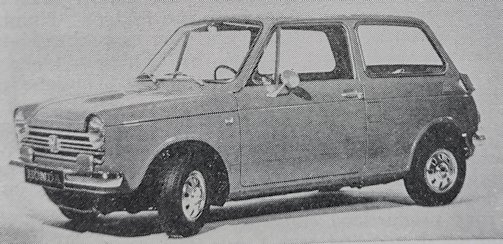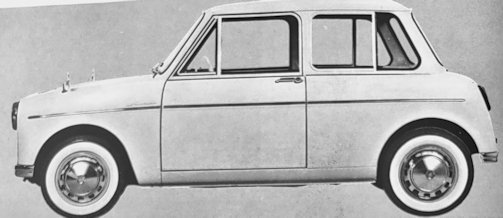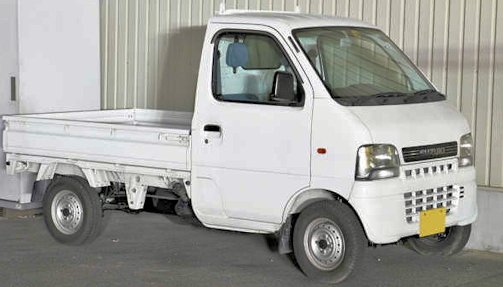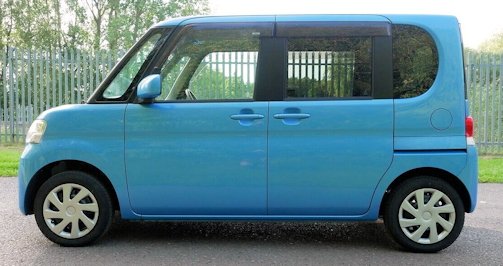Kei Cars

In Japan, a kei car (Japanese 軽自動車, keijidōsha literally means “light automobile”) refers to small cars that have displacement and size restrictions. In addition, a kei car is only allowed to transport a maximum of 4 people (including the driver) - the only exception is that there can be two adults and three children, as long as all three children are under 12 years old.
History
After World War II, the Japanese government introduced the Kei Car class of vehicles in 1949. Initially it was about economic development. In addition, moving from two to four wheels should also be made easier for poorer Japanese people. From the mid-1950s, manufacturers such as Suzuki, Daihatsu, Subaru and, a little later, Honda, which had previously produced cargo tricycles, motorcycles and scooters, also began to produce three- and especially four-wheeled kei cars and from 1960 onwards they also developed trucks (Kei trucks) according to the dimensions of the standard in order to be able to transport larger loads. The production numbers of kei cars rose sharply in the 1960s and ended the boom in motor tricycles. They were initially offered as a cheap segment for poorer rural residents and tradesmen, but they were accepted as full-fledged cars and are now also marketed for families with children, for example. Today they are the most popular class of vehicle. This is due to the financial benefits, but also because, even in busy and modern city centres, there are many small streets that are too narrow for normal-sized cars. The Japanese state has been trying to address the lack of parking space and traffic space for decades and is promoting the use of rail in large cities and trying to shift motorized individual transport from the road to the rail. He is also trying to shift car ownership from large to small cars by promoting kei cars. Through the regulation of Kei cars, which is unique in the world, Japanese manufacturers have this segment for themselves, which is criticized by foreign manufacturers and politicians as isolation. Both Japanese politicians and Japanese manufacturers point out that foreign manufacturers could also adapt themselves with offers for the Japanese market and their models could then benefit from funding as kei cars.
In the years after the Second World War, very small automobiles, so-called scooter mobiles, also emerged in Europe. Like the first kei cars, they were also partly based on motorcycle or scooter technology and were intended as a low-cost segment for the general population who could not afford an expensive, full-fledged car. In common parlance they were also derisively called sucking pins. Some of these European models or light vehicles and small cars also met the Kei Car standard in the past, such as the BMW Isetta (only after the standard was changed, when production had already stopped) or the Fiat Nuova 500 in its later years of production or. its successor, the Fiat 126. In Germany, an affluent trend towards large, heavy cars took hold and the very small, light models lost their relevance on the domestic market. However, there were never any relevant registration figures in Japan. Japan imposed high tariffs on car imports until 1978, but there is still a large trade deficit, particularly for cars. As a non-Japanese manufacturer, Daimler brought a Kei car into series production, the Smart Fortwo as Smart K, onto the market in Japan in 2001. In 2004, production was stopped due to lack of success. It is not because of applicable Japanese import regulations that US automobile manufacturers do not produce kei cars. US manufacturers do not offer any models that meet the Kei car standard. Foreign manufacturers were never able to capture relevant market shares in this segment, even after tariffs were eliminated. Kei cars are not usually produced for export. In general, over 90% of all cars in Japan come from Japanese manufacturers and 93% of registered cars have a displacement of less than 2000 cm³.

There are only a maximum of 4 seat belts and headrests in a kei car. They are a very popular class of vehicle in Japan, especially in rural prefectures, where kei cars are exempt from having to provide proof of their own parking space in many communities, and where in some villages the streets are so narrow that they can practically only be used by kei cars can be driven on. In addition, government support through financial incentives for vehicle taxes, tolls and parking costs, as well as slightly lower maintenance and acquisition costs, ensure brisk demand. In 2020, 40% of registered Japanese cars were kei cars.
There are big differences to small cars from other countries. Despite the small external dimensions, the Kei cars are available in various body styles such as small cars, microvans or off-road vehicles. In Japan there is a wide variety of models in this design that are not common in other markets. The equipment also includes sophisticated features that are not offered in small cars from manufacturers from other countries. Money saved through financial support is often invested in equipment. Kei cars are often available with all-wheel drive, rear camera, proximity radar, driving dynamics control (ESP), xenon headlights or LED headlights, automatic transmission, electric sliding doors or even with an automatic braking system and several airbags. In addition, automatic air conditioning, leather upholstery, variable seating areas or navigation monitors in home cinema format are not uncommon. In addition, turbocharged small engines were developed that adhere to the displacement limit and still offer considerable performance. Kei cars are therefore also available as sports cars, such as the Honda S660.
Kei trucks

In 1960, the Subaru Sambar was introduced as the first Japanese keitora (軽トラ), short for kei-class truck. These models comply with the Kei Car specifications and were developed for transporting loads. In 1961 the Suzulight Carry came onto the market, followed in 1963 by the Honda T360, in 1964 by the Daihatsu HI jet and in 1966 by the Mitsubishi Minicab. Kei trucks are used in particular by transport companies, craftsmen and other businesses, but the fire department also uses special conversions for densely built-up inner-city areas with narrow streets. Special, small, narrow garbage trucks also drive here, but they do not meet the standard of kei cars.
The current regulation on the obligation to provide individual proof of parking space for kei cars is as follows: The obligation to provide individual proof of parking space for kei cars applies in all cities and municipalities within a 30 km radius of the centre of Tokyo and the centre of Osaka. In addition, this obligation also applies nationwide in all other prefectural capitals and also in all cities with more than 100,000 inhabitants.
The toll on Japanese highways is reduced for kei cars. The use of public parking spaces and parking garages is also cheaper for them. They also benefit from the three Japanese vehicle taxes. All you have to do is pay a significantly reduced annual vehicle tax on holding it. When you buy a car, you don't just have to pay VAT. There is also a car purchase tax of 2% (instead of 3%) and a weight tax. Since kei cars also benefit from weight tax and are on average much lighter than cars of other vehicle classes, this also has an impact on maintenance. The weight tax must be paid when purchasing a new vehicle and later during regular shaken inspections.
Kei cars get different coloured license plates. Private cars receive yellow plates with black lettering, unlike other vehicle classes which have a white license plate with green lettering. Commercially registered kei cars have a black license plate with yellow lettering.
In 2013, around a third of all cars in Japan were Kei cars, and over 40% of new registrations for the first time. Despite a 50% increase in vehicle tax for kei cars in 2014, new registrations rose even further. New registrations are now at a comparable level to the total number at 40%. At the end of April 2020, almost 82 million vehicles were registered in Japan. Of these, just over 33 million were Kei cars or Kei trucks. However, at the end of 2019, for the first time since its introduction with the Kei Car Standard Amendment in 1976, the annual Kei Car ownership rate per 100 households fell from 54.41 to 54.40. Although the total number of registrations increased, the proportion of households increased even more, especially in metropolitan regions such as Tokyo and Osaka. In these regions the kei car ownership rate is low, which is due to generally low car ownership. Kei car ownership rates are particularly high in some more rural areas with poor public transport and where incomes are low. Here the odds can be around 100.
In the top five best-selling cars in Japan in 2019, the first four places were occupied by kei cars: Honda N-Box, Daihatsu Tanto, Suzuki Spacia and Nissan Dayz. Only in fifth place comes the Toyota Prius, a vehicle from a different vehicle class. The Suzuki Twin was the first kei car with hybrid drive from 2003 to 2005. The first purely electric kei car in series production was the Mitsubishi i-MiEV from 2009 to 2020.

Description
Technical
-
Kei car standard
Over the years, the limits for kei cars have gradually been increased slightly. Since 1998, they have had today's typical dimensions of a maximum of 1.48 by 3.4 meters, which means that they are usually significantly narrower than small cars from other countries.
Date
Maximum*
length
(in m )Maximum*
width
(in m)Maximum*
height
(in m)Maximum*
displacement (cm³)
Maximum
Performance
Four-stroke
Two-stroke
1949
2.8
1
2
150
100
not specified
1950
3
1.3
300
200
1951
360
240
1955
360
January 1, 1976
3.2
1.4
550
January 1, 1990
3.3
660
64 hp (47 kW )
1998
3.4
1.48
Maximum* means here that all real values must be smaller than the specified limit values. A current kei car may not be around 3.40 m long, but only a maximum of 3.395 m and 1.475 m wide, and may initially only have a maximum displacement of 658 cm³ (as the displacement slowly increases due to abrasion)



